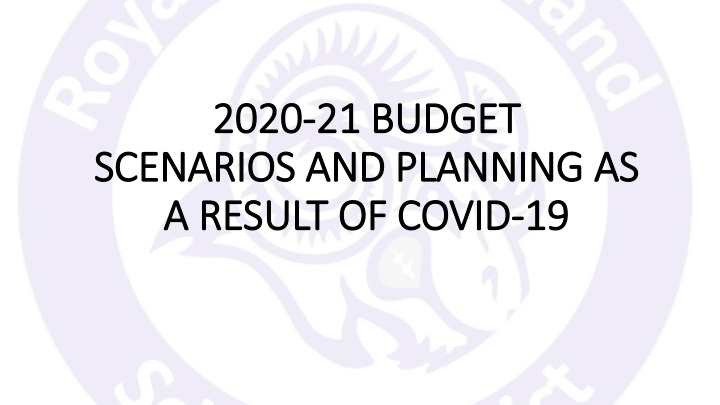



2020 2020-21 B 21 BUDG DGET ET SCE SCENARIOS AN AND P PLA LANNING AS AS A R RESUL ULT OF OF C COVI VID-19 19
CURREN URRENT T KNOWN F FACTORS • Decrease in expenditure driven aid: Transportation, BOCES, etc… • Potential for state aid payment delays (this year) • Potential for state aid reduction (next year) • Comptroller has suspended the financial condition portion of the District’s audit
ADDITIONA ONAL A ASSUMPTION ONS • The state will lose huge amounts of sales tax revenue as businesses respond to the shutdown order • The state will lose revenue from investments that have been tied to the failing stock market • The cost of basic supplies will continue to rise, if available, and will further stress consumers • Federal debt will be unsurmountable as Washington attempts to stop the financial bleeding as a result of a crippled market • State’s Medicaid services will skyrocket (more claims added to an already unsustainable amount) • The State will assume huge increases in unemployment insurance costs that may never had been seen or anticipated before
ADDITIONA ONAL A ASSUMPTION ONS “DiNapoli estimates tax revenue will be at least $4 billion below the projections in the Executive Budget of $87.9 billion. He also offered one alternative scenario if a more severe recession or sharper declines in the stock market occur, which could lower tax revenues by more than $7 billion.” “Definitive estimates of the COVID-19 impact on the economy and State revenues are not possible, in part because the ultimate health and social impacts of the virus are currently unknowable. Most available economic forecasts have not yet caught up with recent events, although projections have broadly weakened.” “It is important to note that other developments are likely to have material impacts on the Financial Plan in the coming year, and perhaps beyond.” Source: https://www.osc.state.ny.us/press/releases/mar20/031720.htm
Goal als i in n Plan anning f for 2020 2020-21 a and B Beyond 1) Maintain quality programming for our students 2) Realize the potential impact on State Aid 3) Plan the use of appropriated fund balance and reserves 4) Identify areas of efficiency and prepare for a potential revenue shortfall
What C Can We D Do? 1.) Reserve Contributions 2.) Protect fund balance 3.) Conservatively Estimate State Aid 4.) Adjust Long Range Financial Plan Accordingly 5.) Reduce Expenditures - New Positions - Reduction through attrition - Operating expenditures - Consolidation
Potential Budgetary Reductions • A freeze on adding new positions = $270,000 Business/Ag , MS Teacher, ES Special Education, Additional Accounting Support, Additional Clerical Support • Reduction through attrition = $250,000 ES Music Teacher, ES Physical Education Teacher, MS Math Teacher • Reduction of TOSA positions = $170,000 Technology Integrator TOSA and Dean of Students TOSA • 50% Reduction in supplies and reduction of non-essential equipment = $260,000 • Additional potential reductions realized through staffing efficiencies = $200,000 • Non-instructional programs and BOCES services = $100,000 • Total identified reductions = $1,250,000
Budget Timeline – Additional B Budget P Plann nning Meetings?
Questions from the Board of Education?
Recommend
More recommend